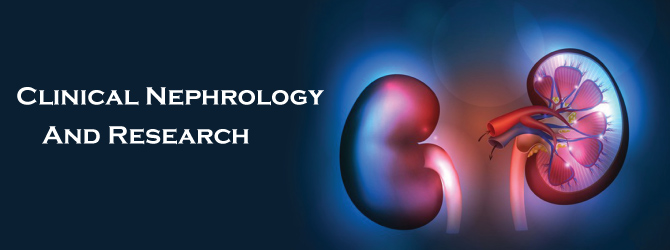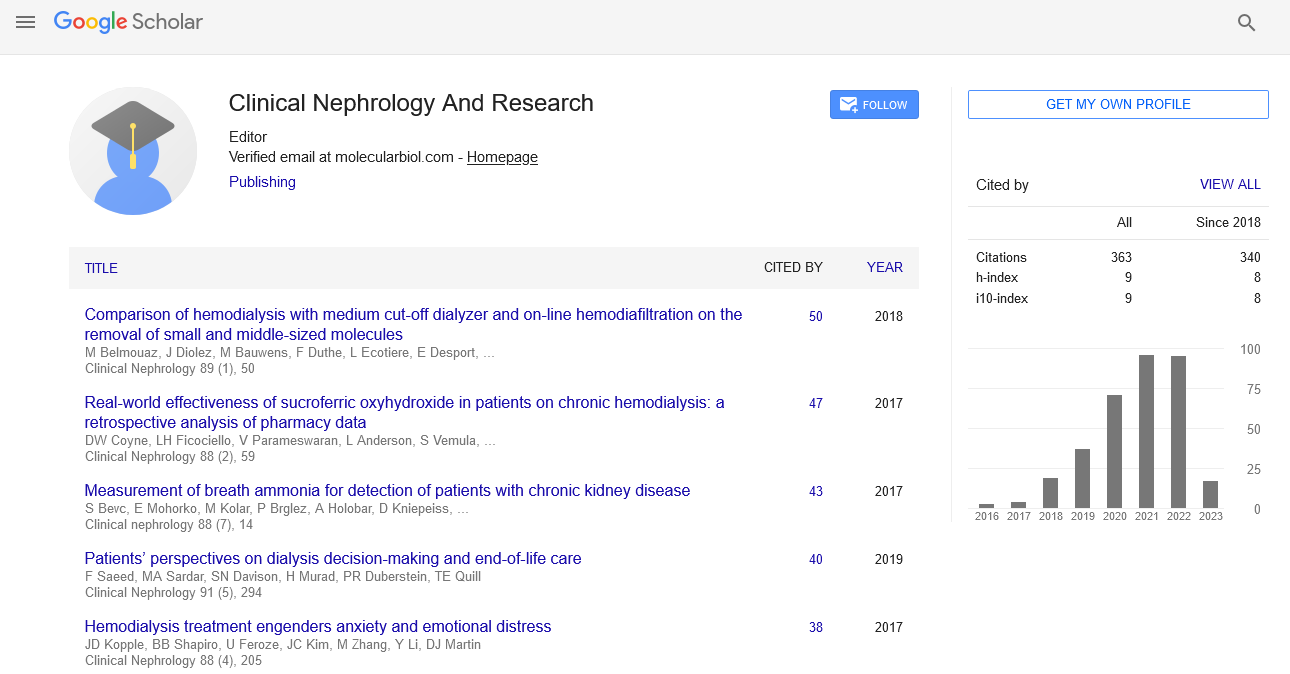Renal function and total renal volume were measured after radical nephrectomy for renal malignancy
Received: 05-May-2024, Manuscript No. PULCNR-24-6405; Editor assigned: 08-May-2024, Pre QC No. PULCNR-24-6405 (PQ); Reviewed: 23-May-2024 QC No. PULCNR-24-6405; Revised: 05-Jul-2024, Manuscript No. PULCNR-24-6405 (R); Published: 30-May-2024
Citation: Klausner J. Renal function and total renal volume were measured after radical nephrectomy for renal malignancy. Clin Nephrol Res 2023;7(1):1-2.
This open-access article is distributed under the terms of the Creative Commons Attribution Non-Commercial License (CC BY-NC) (http://creativecommons.org/licenses/by-nc/4.0/), which permits reuse, distribution and reproduction of the article, provided that the original work is properly cited and the reuse is restricted to noncommercial purposes. For commercial reuse, contact reprints@pulsus.com
Abstract
After a Radical Nephrectomy (RN) for a renal malignancy, the kidney on the opposing side may enlarge to replace the lost renal mass. The development of Renal Function (RF) will depend on the ability to compensate. Total Renal Volume (TRV) measures of the remaining kidney recorded before and after RN can be used to gauge the progression of the RF.
Keywords
Radical nephrectomy; Total renal volume; Renal function; Acute kidney failure; Chronic kidney disease
Introduction
Neoplasms of the kidney are more frequent today than they were a few years ago. Clear cell carcinoma, with an incidence of slightly fewer than 3%, is one of the most prevalent adult malignancies. Since in clinical practice this constitutes a significant cause of acute renal failure and/or the onset of chronic kidney disease, the nephrologist has a significant and vital role in the management, care, and monitoring of the development of kidney function. Acute Kidney Failure (AKF) occurs in 33% of patients who have undergone radical nephrectomy, and these individuals are four times more likely to develop Chronic Kidney Disease (CKD). The risk is lower for those who have had partial nephrectomies. After radical nephrectomy, various compensatory mechanisms are immediately started on the remaining kidney to lessen the decline in glomerular filtration rate.
Since Renal Function (RF) is the main indicator of the course and outlook for Total Renal Volume (TRV), which is measured using the ellipsoid equation, it is a frequently used tool in polycystic kidney disease.
Description
Measuring the TRV of the remnant kidney in patients with renal neoplasms prior to and following radical nephrectomy (after one year of follow-up), although it hasn't been thoroughly studied, could help evaluate the evolution of renal function and identify the factors that may affect the change in renal function. The objective of this study was to assess the correlation between the pre and post-nephrectomy TRV in the remaining kidney and the eGFR at the one-year follow-up.
The results of this study suggest a favourable relationship between pre and post-nephrectomy TRV and pre-nephrectomy eGFR. Surprisingly, after a year of follow-up, there was a poor correlation between the eGFR and TRV. This finding conflicts with what is previously known based on prior study, which showed that compensatory mechanisms are triggered early in an effort to mitigate the decline in glomerular filtration rate when 50% of the renal mass is lost after radical nephrectomy. These pathways, which ultimately determine the development of renal function and the likelihood of progression to CKD, can be altered by factors including age, smoking, obesity, hypoalbuminemia, post-nephrectomy acute renal failure, and hypoalbuminemia.
Whether the compensatory mechanisms that follow nephrectomy in the context of renal oncology are different from those found in other clinical situations is yet unknown. Thus, it has been found in several studies that there is a negative correlation between renal function and tumour size, especially in cases where the tumour is larger than 5 cm. The 6 cm median size of the tumours in our sample may have contributed to the weak correlation between post-nephrectomy renal function and function.
The progression of renal function following the loss of renal mass in the nephrectomies population displays different behaviours depending on the aetiology that caused the removal. Nephrectomies done on individuals for reasons other than kidney donation have a variety of outcomes, but it seems that there is no obvious loss of kidney function in patients who survive after receiving a kidney transplant during the course of follow-up. Especially if they are young and free of substantial comorbidities, patients who underwent nephrectomy for non-cancerous causes usually preserve renal function years after the treatment. However, some published series show worse results, such as a steady decline in renal function, the onset of proteinuria, and the emergence of CKD.
The conclusions from this study may be limited by its retrospective design, but they do serve to demonstrate that in patients who underwent nephrectomies for renal neoplasms, the evolution of the eGFR at one year of follow-up is strongly correlated with the measurement of pre and postnephrectomy TRV in the remaining kidney using the ellipsoid equation. These factors may be useful in assessing renal function and the possibility for compensatory function of the remaining kidney.
Studies on Post-Traumatic Epilepsy (PTE) in large animal models are scarce. Neocortical PTE has been better understood thanks to recent developments in neocortical microscopy. Nevertheless, it is incredibly difficult to induce believable neocortical PTE in rodents. Hence, large animal models that expand neocortical PTE can also offer helpful insights that may yet be better suited to human patients.
Long-term video EEG recording is necessary because to the lengthy latent periods of gyrencephalic species. Here, we provide documentation of a fully subcutaneous EEG implant in freely moving pigs for up to fourteen months during epileptogenesis following bilateral cortical effect accidents or phantom surgical procedures. The advantages of this device include the availability of an easily installed, commercially available device, a low failure rate following surgical EEG implantation, radio telemetry that allows continuous tracking of freely moving animals, excellent video to EEG synchronization, and a high signal to noise ratio.
The accretion of cranium bone, which entirely encased a portion of cranial screws and EEG electrodes, and the inability to arrange the EEG electrode array are the hazards of this device on this species and age. These dangers can be reduced by employing implants for a larger meaningful montage and by using splicing a subdural electrode strip to the electrode leads so that cranium growth is less likely to interfere with long-term signal capture. Researchers studying epileptogenesis in PTE can benefit from this commercially available gadget on this bilateral cortical effect swine version.
PTSD related epilepsy
Traumatic Brain Injury (TBI) has a significant impact on patients longevity, and those who survive the initial phases of TBI typically have an elevated risk of later-life disability and comorbidity. In this situation, Post-Traumatic Seizures (PTS) and Post-Traumatic Epilepsy (PTE), two disabling sequelae of traumatic brain injury, are frequent.
PTS is categorised as "Early" Post-Traumatic Epilepsy (EPTS) if it starts within 7 days of the event and "Late" Post-Traumatic Epilepsy (LPTS) if it starts more than 7 days later, depending on when it starts. It is categorised under. The distinctions between the underlying mechanisms and the risk of more seizures are reflected in this cutoff. A main damage mechanism linked to EPTS5, sometimes referred to as acute symptomatic seizures, temporarily reduces the seizure threshold. Instead, LPTS is defined by enduring neurobiological changes brought on by secondary injury, and the likelihood of further seizures is determined by a biochemical cascade of epilepsy development pathways.
The International League Against Epilepsy (ILAE), which recently redefined clinically what constitutes epilepsy, now considers LPTS to be epileptic if there is a risk of subsequent seizures following one unprovoked seizure that occurs more than seven days after a traumatic brain injury. For, it is high enough. Hence, PTE and LPTS are frequently used as synonyms. While PTE accounts for 10-20% of symptomatic epilepsy in the general community and 5% of all epilepsy, the overall incidence of PTE among inpatients is only about 3-5%.
Acute seizures have a significant impact on the progression of new brain injury. Particularly, EPTS seems to raise the likelihood of PTE development and increase morbidity and mortality in the initial phases following TBI.
Conclusion
Taking into account all of these variables, clinical practice frequently employs early post-TBI seizure prevention, with various degrees of success. It has been a subject of study for decades as a result. Anti-epileptic Medications (ASM) have been shown to be effective in preventing EPTS, but there is no evidence to support their superiority to LPTS and PTE. In fact, the use of preventative therapy is advised by the most recent brain traumatic foundation guidelines 20 to lower the risk of EPTS within 7 days of severe TBI. Before to its problems, phenytoin was the medication of choice for prophylaxis; however, levetiracetam is now a more popular substitute.





